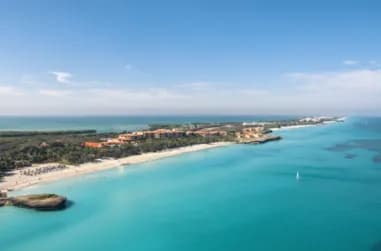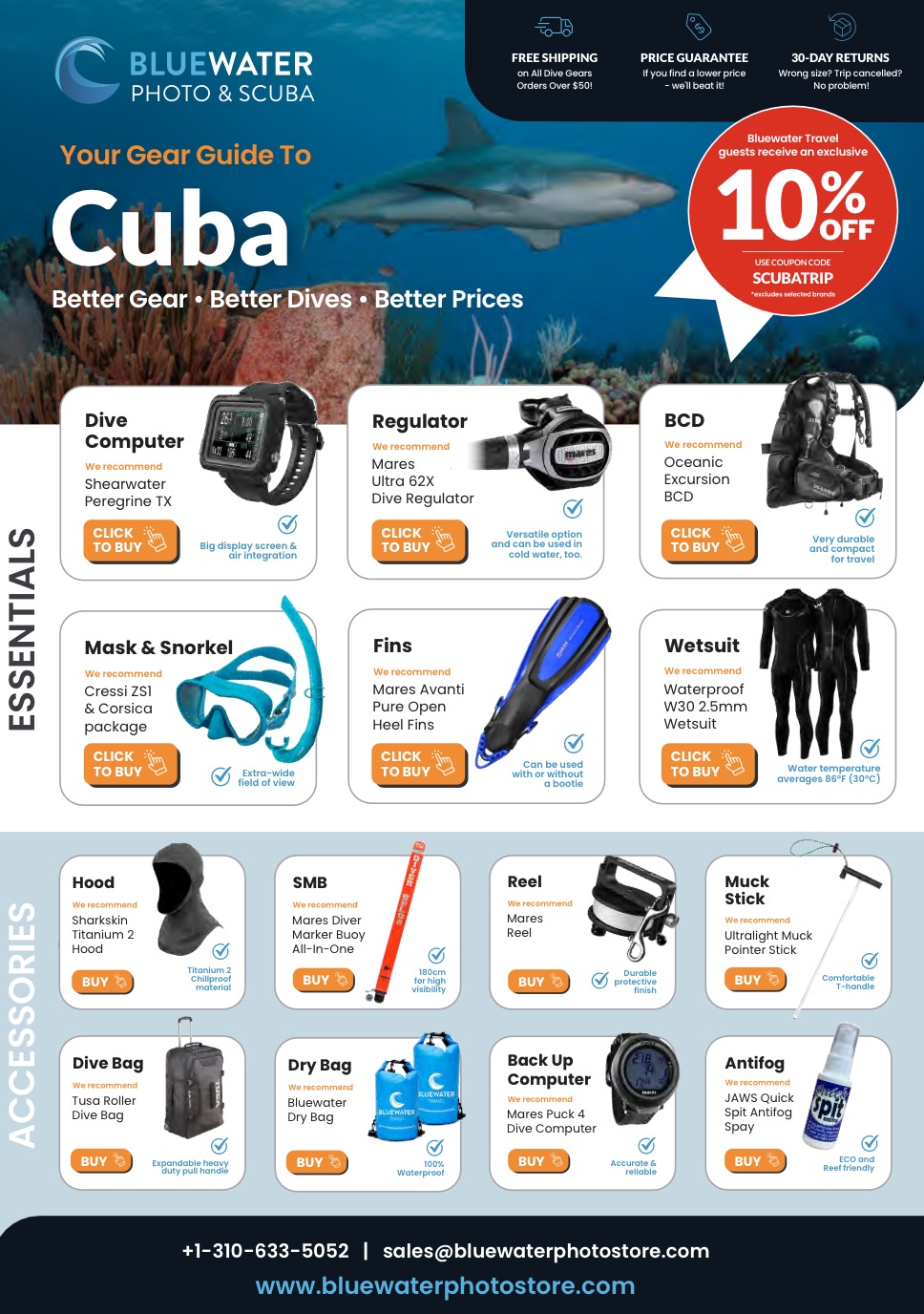We Know Because We Go! | Book with a 5-Star Team,| Trusted by 10,000+ Divers
Best Scuba Diving in Cuba
Offering beautiful coral reefs, world-class shark diving, a rich variety of marine-life, and the rare opportunity to dive with saltwater crocodiles, scuba diving Cuba means diving one of the best Caribbean diving destinations.

Destination Highlights
Average flight time from LAX
7
Scuba Dive Level
All Levels
Visibility
65 to 130 feet (20 to 40 meters)
Average Water Temperature
80
Wreck Diving
Stunning Reefs & Corals
Scuba Diving In Cuba
Cuba Diving Highlights
An excellent destination for scuba divers of all levels, Cuba is also known for its unique culture and history which makes it just as interesting to discover topside. Divers and non-divers alike will have plenty of things to experience and explore on Cuba diving trips!
Check out the trip report and photos from one of our dive trips to Cuba!
Intro To Cuba
The Cuban archipelago is situated in the northern Caribbean where the Caribbean Sea, Gulf of Mexico, and Atlantic Ocean meet. This mix of ocean systems creates a unique and exciting habitat, rich in inquisitive nature. The islands' flora is marked by endemic and assorted plant groups, with orchids, desert flora, and palms being the highlighted ones. The extravagance and endemism of Cuba's fauna are endless. The marine life and wetlands, living fossils, endangered species, and essential coral reefs are known to have an extraordinary value and worldwide acknowledgment. Cuba sits on the second largest barrier reef system in the world, and as such its marine ecosystem is the jewel of the Caribbean. Diving Cuba is an exceptional experience, and visitors will discover something new and exciting both above and below the waves.
Diving Information
Marine Life & Environment
Diving Cuba you can expect to swim over vibrant reefs boasting 50 species of coral and 200 species of sponge. These in turn play host to a plethora of interesting marine life such as jewfish, stingrays, green morays, turtles, and Atlantic spadefish. Cuba is known as a great shark destination, and the good visibility makes it easy to spot several species of reef shark patrolling the edges of the reef. In addition to this, diving deeper sites will reveal schools of jack, tuna, tarpon, and barracuda, as well as grunts, snappers, red hinds, parrotfish, squirrelfish, and triggerfish. Finally, Cuba hosts a surprising array of critters, and those that make the effort to search amongst the coral heads will be rewarded with lobsters, crabs, shrimps and numerous other macro species.
Where to Dive Cuba
Jardines de La Reina
The highlight of any dive trip to Cuba, Jardines de la Reina was declared a Marine Park in 1996. This uninhabited area has been preserved for future generations as a complex network of untouched marine ecosystems. It is regarded by many scientists and organizations as a reference of the original status of a coral reef. This world-class diving location is, indeed, an underwater paradise; imagine vertical walls covered with brightly hued sponges, huge pilar corals, black corals extending their branches in the contrasting blue water. Divers can discover many species of gorgonians and fragile laminar corals displaying their beautiful shapes through crevices, canyons, and caves. While saltwater crocodiles have become more elusive in the area, sharks and large groupers are plentiful.
Cayo Largo del Sur
The epitome of tropical paradise, Cayo Largo del Sur's endless white sand and shallow lagoon is the perfect location to start your dive career or earn additional certifications. The pristine barrier reef lies less than a mile offshore, where divers can discover an abundance of tropical fish in the warm, clear water. Venturing to the ocean-side of the reef reveals exciting drop-offs, caverns and grottos, and even a couple of wrecks.
La Habana
Home to several interesting wrecks, La Habana's history is well worth exploring above and below the waterline. Diver will be pleasantly surprised at the rich marine life on wrecks such as the Coral Island merchant ship, and the Sanches Barcastegui.
Playa Giron & Playa Larga
Boasting a wide range of dive sites to explore, these two beachfront locations offer some fantastic shore diving along the nearby reef. A vibrant display of corals and sponges attract a tantalizing array of fish, from small tropical species to larger ocean-going pelagics, and even dolphins. Playa Giron also has a cenote dive where visitors can discover unusual cavern dwelling species.
Varadero
This famous peninsula juts out into the Nort Atlantic Ocean and is almost as remoted as the tiny islands spread out from its tip. Warm, clear water hides several worthwhile shipwrecks, while the reefs are alive with unspoiled coral gardens. There is some fascinating underwater topography to be found, including cavern and caves, cenotes, and some unique rock formations.
Diving Conditions
- Water Temperature: Varies from 22C (72F) in December to 29C (84F) in July
- Visibility: 20 - 40 m (65 - 130 feet)
- Weather: Climate varies slightly during the year. Drier season (December to mid-April): 73 to 77F (23-25C); Height of summer (August): 83F (28C)
Best Dives Sites In Cuba
Here are some of the best dive sites to explore on Cuba diving trips:
1. Pipn - At the mooring buoy, the reef is 15 meters deep, forming impressive canyons and caves that run perpendicular to the coastline until they reach 24 meters of depth at the edge of the drop-off. At this point, the reef is very colorful and alive, with huge schools of grunts patrolling the border of the abyss; many jacks; silver tarpons in groups of 10-50 coming straight at you and then making a swift turn 5 inches away from your mask, along with turtles, eagle rays flying near the wall and sometimes a lonely three-meter-long great hammerhead coming up from the deep to take a quick look at the divers and then disappearing into the blue. In the meantime, as divers go around the canyons, a group of 10-12 silky sharks keep swimming close to the surface near the boat; then, during the safety stop, they come to get an eyeful of the divers.
2. Faralln - This is one of the best dives in Jardines de la Reina. Faralln is a giant coral mountain 17 meters deep at the top and divided into four parts by tunnels that run across and end at a white sandy bottom of 29 meters. These tunnels are about 30 m. long, 3 m. wide and 10 m. high, with an opening at the top that allows the sunlight to pour through, creating a spectacular show of light and shapes, giving the diver the feeling of flying across another world. Same species as in Pipn plus the reef shark (Carcharhinus perezi) swimming close to the bottom.
3. Vicente - Dive along the drop-off, with coral mountains at the edge descending from 20 m. to 40 m. and then to the abyss (800 m.). Visibility is more than 40 meters. You can find massive black coral colonies in the wall; also, the mysterious and shy great hammerhead shark (Sphyrna mokarran) sometimes emerges from the blue to show its incredible body shape and elegance.
4. Black Coral I and II - These two dives are the most exciting! Minimum depth is 24 meters on top of the reef, then a sandy bottom at 30 m. Channels run across the reef perpendicular to the coast, until they reach the drop-off; at this place, there is a resident population of more than 30 reef sharks (Carcharhinus perezi) that get very close to the divers (sometimes 10 inches away from the mask). After 15 minutes of breathless watching at these creatures, while they swim around, the dive continues close to the coral formations and sandy channels with sleeping stingrays (Dasyatis americana), parrotfish, big black groupers and tons of jacks swimming near divers until the end of the dive.
How To Get To Cuba
Visitors can arrive in Cuba by air or by sea. There are numerous international air and cruise terminals with regular direct flights from Canada and Europe. The most common way is to fly into Havana’s José Martí International Airport (HAV) and then take a connecting flight to your resort.
How To Dive Cuba
There are a good number of Cuba diving resorts spread around the island, and the main dive centres offer a choice of operators. Cubas Jardines de la Reina is served by floating hotels and only 900 guests per year are allowed.
Topside & Non-Diving Activities
Cuba has a fascinating history and unique culture that sets it apart from its Caribbean neighbours. Everything from the food to the music, as well as the genuine Cuban hospitality, will make you feel welcome. The nightlife in Havana is world-renowned, and baseball is a popular national pastime.
- Great beaches
- Shopping
- Tours, rides, circuits and excursions around different tourist destinations of the island
- Sailing, sports fishing, water skiing and snorkeling
- Bird watching, hiking, diving, sports fishing, outdoor horseback riding, caving, mountain biking or rural tourism
- Golf
- After-dark entertainment scene
Practical Information
- Currency: Cuban Convertible Pesos
- Language: Spanish, but many Cubans have studied either English, French, German or Russian
- Time Zone: UTC-4 or UTC-5
- Electricity: 110/230 volts AC, 60Hz
Recommended Scuba Gear
Download our full scuba gear guide to Cuba, Bluewater Travel guests receive 10% OFF! Click the image below to download (PDF).


- Wetsuit. 2.5mm. Warm ocean averaging around 30C/86F. Waterproof W30 2.5 wetsuit.
- Mask and Snorkel. Perfect travel package. Cressi ZS1 & Corsica Snorkeling package.
- BCD. Very durable and compact for travel. Oceanic Excursion BCD.
- Fins. Can be used with or without a bootie. Mares Avanti Pure Open heel fins.
- Regulator. Light and easy to travel with. Mares Ultra 62X.
- Dive Computer. Nitrox compatible with replacement batteries. Shearwater Peregrine.
- Travel Bag. Dive travel Bag. Tusa Roller bag
Tick list